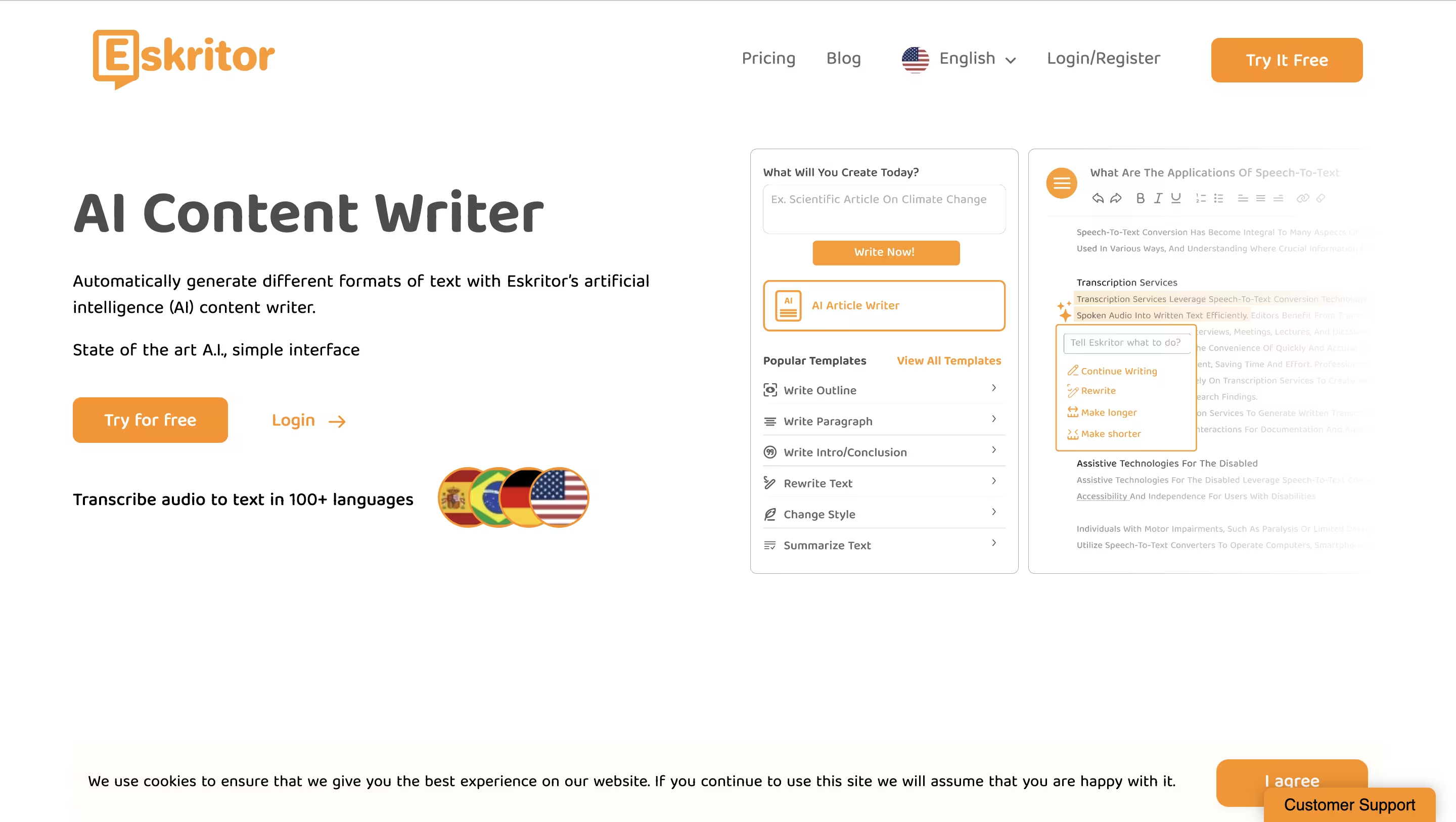Copywriting as a career demands creativity, storytelling skills, and analytical skills. Before writing your first copy, it is crucial to understand what is copywriting. Copywriting requires many skills, and every skill has a logic behind it.
In this blog, you will learn what persuasive writing is and how to create engaging content. Explore some SEO copywriting basics to increase traffic on your website. While you learn that crafting compelling ad copy is essential, learn the benefits of using AI tools for copywriting. Discover the best writing assistants for copywriting, such as Eskritor.

Understanding Copywriting
A copywriter is behind every copy that persuades you to know about a product or service. You can find copywriting in print, online, television, or radio.
What is Copywriting?
Copywriting means creating compelling copy that markets a product or service to a target audience. Copywriting aims to persuade readers to take desired actions. This includes buying a product, ordering food, or buying a service.
Copywriting is different from content writing. While content writing is information-oriented, copywriting is persuasive. It motivates people to take a specific action. Some examples of copywriting include a perfume ad in a newspaper or a discount that prompts you to buy something.
Key Characteristics of Effective Copywriting
Effective copywriting is majorly based on the “Four Cs.” These are; clear, concise, compelling, and credible. If you follow this formula, you are on the right track to get effective results.
Clear
The right amount of thought matters the most when writing a copy. You should clearly state what you are selling for the consumer to understand. You must have a deep knowledge of the product to achieve this level of clarity. The message should be readable, so use simple words and short sentences.
Concise
A concise copy means to get your message in a few words without skipping any important feature. You can write about the product in one short sentence to achieve this. Next, create a word dump to avoid omitting essential features. Next, eliminate redundancy and rambling. Finally, write the features in a copy style and add them one at a time to a short sentence.
Compelling
Compelling means telling the consumer what is in the product or service. A persuasive message makes any copy relevant to the audience. Instead of focusing on the features more, you should address the pain points. There is a PAS formula, which stands for Pain, Agitate, and Solve. Using this, you can get the main idea of pain points, how to analyze them, and how to solve them.
Credible
Appearing credible is essential to selling something. Product credibility comes from its ad and branding. Branding builds trust, and ads offer services, benefits, and more. For example, mentioning discounts and free trials is a part of the ad copy.

The Basics of Persuasive Writing
Persuasive writing aims to let the reader/user agree with your point of view. You need to give logical reasoning, supporting evidence, and arguments. Here are some of the essentials of persuasive writing that you can implement from start to finish:
- Understanding Your Audience: Know your audience by analyzing demographics, pain points, goals, interests, and online behavior to create content effectively.
- Crafting a Clear Message: Communicate your main idea, especially in the opening, to avoid confusion and engage the reader with the right language.
- Using Emotional and Logical Appeals: Ethos (character), logos (logic), and pathos (emotion) lets you build credibility and connect with readers emotionally.
Understanding Your Audience
The audience comprises people who will engage with your content. To know your audience, you must consider demographics, pain points, goals, interests, and online behavior. Demographics include age, gender, education level, and location. Interests can include hobbies and passions.
Pain points refer to challenges or problems a particular product/service can solve. Goals refer to audience aspirations and how you can help them achieve them. To understand their online behavior, find out where they spend their time online and what platforms they use.
Crafting a Clear Message
A clear message openly communicates the central idea of a piece of writing. In a persuasive copy, your message is the point of view that you are trying to convince the reader of. It is best to include it in the introduction or opening of your copy to avoid confusion.
You will have difficulty convincing the reader if they do not know what you are discussing. Choosing the right words and phrases is crucial in persuasive writing. It is a way to build a personal relationship with the reader.
Using Emotional and Logical Appeals
There are many ways to persuade people through writing, including ethos, logos, and pathos. From 367 to 322 BCE, Aristotle first introduced this mode in his treatise Rhetoric. It has become the core of modern persuasive speech.
Ethos means character, and it refers to how the author presents. Here, the author must demonstrate their skills, virtue, and goodwill towards the reader to present themselves in the best light.
Logos means logic and refers to using logical arguments and evidential data. A good copywriter backs up their perspective with statistics and facts. Logos also means to structure your argument in the best way possible.
Pathos means suffering and involves the appeal to the emotion of an author. Humans tend to make decisions based on emotions, so a good copywriter is. You can share a personal experience to sympathize with the reader and urge them to consider their feelings.
Types of Copywriting and Their Applications
Each type of copywriting serves a specific purpose. Some can be to sell a product, while others can be to create an impact. Some kinds of copywriting include marketing, sales, and SEO. Here is a detailed insight on all three types:
- Marketing and Ad Copy: Ad copy encourages action with a call to action, using emotional appeals and powerful headlines.
- SEO Copywriting: By blending SEO techniques with quality writing, you can create content that ranks well on search engines.
- Sales Copy: Sales copy persuades consumers to take action, focusing on the benefits of a product or service to drive interest and conversions.
Marketing and Ad Copy
Ad copy prompts the reader to take action with a call to action (CTA). It uses powerful headlines that appeal to consumers' emotions, including desire, fear, and curiosity. Ad copy appeals to the logical and emotional audience and addresses consumer queries.
There are many types of ad copies, such as Google Search ad copies, display ad copies and social media. Google Search ad copies can be competitive, goal-oriented, authoritative, and conversational. Display ad copy, including rhyming and bragging ad copies.
SEO Copywriting
You can successfully blend SEO fundamentals and good copywriting techniques This way, you can create valuable content that ranks high on search engines. Before you start writing, you must have a list of relevant keywords to target.
Most people look for blog posts, videos, product pages, category pages, and tools when they search for something on Google. You can use SEO copywriting tools like Ahrefs, Google Search Console, Grammarly, etc., to create content more efficiently.
Sales Copy
Sales copy persuades consumers to take specific actions. You can use it to convince readers to buy a product or service. Sales copy is part of informative media like emails, brochures, and web pages. If you sell a product using sales-focused copywriting techniques, you should prioritize its benefits more than its features. A sales copy is a hook intended to drive interest and action.

Tips for Writing Engaging Copy
A copy starts with a headline and ends with a call to action (CTA). From start to end, a branding experience engages the reader. Although ad copies are concise, making them compelling with few words is tough. Here are some tips for writing effective marketing copy:
The Power of Strong Headlines
You need a great headline because you should be mindful of how you present your ideas in a copy. A headline should be clear and compelling, piquing curiosity and making them want to know more.
You can use different types of headlines. For example, in headlines with a question, you should ask questions you know your audience wants the answer to. In “How to” headlines, follow up with whatever action or insight you want your readers to take away.
Testimonial-style headlines rely on customer quotes to do the selling for you. With these headlines, potential customers can immediately see the benefits of your product. Similarly, other types exist, such as listicles, direct/indirect, name drop, and more.
Using Storytelling in Copy
Research shows that infusing your copy with storytelling can boost your conversion rates by up to 30%. Your stories must be consistent, and a brand can have multiple stories. These stories must relate to your audience, establish authority, and build personal connections.
75% of customers believe that brands should use storytelling in their marketing. Instead of using vague words and abstract concepts, be specific. One good way to do this is to use all or some senses. For example, explain the scenario that upset you instead of using terms like sad or upset.

How AI Tools Like Eskritor Help with Copywriting
Eskritor is an AI-powered writing assistant and tailored blog writer. Eskritor is for business owners, marketers, and freelancers. This AI text generator can boost your search rankings. It creates content-optimized blogs for your target keywords.
- Streamlining the Writing Process: AI-powered tools like Eskritor simplify copywriting by generating outlines, summarizing articles, and more.
- Enhancing SEO and Keyword Integration: Eskritor optimizes posts for search engines, saves time, repurposes content, and enables frequent publication.
- Boosting Creativity and Efficiency: With 50+ customizable templates and advanced AI algorithms, Eskritor supports diverse writing needs.
Streamlining the Writing Process
Depending on your topic, copywriting may require extensive research and writing. The process is typically monotonous and time-consuming. This is where AI-powered writing tools can make a difference.
According to a survey by Statista, 51.5% of employees at Polish companies believed that AI can replace copywriters. So, you can combine human insight with AI content tools like Eskritor to spike your creativity.
The tool can generate outlines, summarize articles, and give writing tips within minutes. AI also provides SEO guidance and builds a strong foundation of SEO best practices. It includes keyword research assistance, meta-generation, and linking suggestions.
Enhancing SEO and Keyword Integration
Eskritor offers an innovative content enricher that allows you to optimize your posts for search engines. Eskritor helps you save time, and you can publish 4-6 content pieces weekly. This will keep your readers engaged, and you can work more on research and creativity.
As a copywriter, you can create AI-generated drafts quickly. This ensures that you and your client are on the same page, saves time, and leaves a good impression, increasing client retention rate.
You can also use Eskritor to repurpose your blogs into social media posts and email campaigns for marketing. If you are a small business owner, it saves on hiring content writers by generating high-quality blogs at a fraction of the cost.
Boosting Creativity and Efficiency
Eskritor has 50+ templates designed for various niches and styles. As a freelance writer, you can use Eskritor to adapt to different client needs. It offers a wide range of customizable blog templates and tones. Eskritor helps with article generation, content editing, rewriting, and many other services.
It uses advanced AI algorithms to generate accurate and coherent content. Whether you are generating fresh content or using it for high-quality rewrites, Eskritor does it all. It mimics human writing patterns and lets you easily modify and refine your documents. You can make precise adjustments to ensure your writing is error-free.
Conclusion
As of now, you must have gained extensive insight into what copywriting is. With the help of AI tools, you can boost efficiency in your workflow. While numerous AI tools exist for copywriting, Eskritor stands out for its reliability and accuracy.
Whether you are a freelancer or a business owner, Eskritor is for all. It can tailor your content with templates and writing styles. Eskritor uses natural language processing (NLP) and machine learning algorithms to generate content on various topics.






 location
location